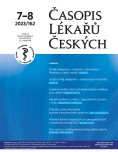Artificial intelligence’s contribution to early pulmonary lesion detection in chest X-rays: insights from two retrospective studies on a Czech population
Authors:
Martin Černý 1,2; Daniel Kvak 1,3; Daniel Schwarz 4; Hynek Mírka 5; Jakub Dandár 1
Authors‘ workplace:
Carebot s. r. o.
1; Neurochirurgická a neuroonkologická klinika 1 LF UK a ÚVN Praha
2; Ústav simulační medicíny LF MU v Brně
3; Institut biostatistiky a analýz LF MU v Brně
4; Klinika zobrazovacích metod LF UK a FN Plzeň
5
Published in:
Čas. Lék. čes. 2023; 162: 283-289
Category:
Original Article
Overview
In recent years healthcare is undergoing significant changes due to technological innovations, with Artificial Intelligence (AI) being a key trend. Particularly in radiodiagnostics, according to studies, AI has the potential to enhance accuracy and efficiency. We focus on AI’s role in diagnosing pulmonary lesions, which could indicate lung cancer, based on chest X-rays. Despite lower sensitivity in comparison to other methods like chest CT, due to its routine use, X-rays often provide the first detection of lung lesions.
We present our deep learning-based solution aimed at improving lung lesion detection, especially during early-stage of illness. We then share results from our previous studies validating this model in two different clinical settings: a general hospital with low prevalence findings and a specialized oncology center. Based on a quantitative comparison with the conclusions of radiologists of different levels of experience, our model achieves high sensitivity, but lower specificity than comparing radiologists.
In the context of clinical requirements and AI-assisted diagnostics, the experience and clinical reasoning of the doctor play a crucial role, therefore we currently lean more towards models with higher sensitivity over specificity. Even unlikely suspicions are presented to the doctor. Based on these results, it can be expected that in the future artificial intelligence will play a key role in the field of radiology as a supporting tool for evaluating specialists. To achieve this, it is necessary to solve not only technical but also medical and regulatory aspects. It is crucial to have access to quality and reliable information not only about the benefits but also about the limitations of machine learning and AI in medicine.
Keywords:
artificial intelligence, deep learning, computer-aided diagnosis, chest X-ray, lung cancer, solitary pulmonary nodules, pulmonary masses
Sources
- Barreiro-Ares A, Morales-Santiago A, Sendra-Portero F et al. impact of the rise of artificial intelligence in radiology: What do students think? Int J Environ Res Public Health 2023; 20 (2): 1589.
- Donald J, Barnard S. Common patterns in 558 diagnostic radiology errors. J Med Imaging Radiat Oncol 2012; 56: 173–178.
- Stručný přehled činnosti oboru radiologie a zobrazovací metody za období 2007–2020. ÚZIS, 2020. Dostupné na: www.uzis.cz/res/f/008333/nzis-rep-2020-k19-a049-radiologie-a-zobrazovaci-metody-2019.pdf
- Dušek L, Mužík J, Kubásek M a kol. Epidemiologie zhoubných nádorů v České republice. Masarykova univerzita, Brno. Dostupné na: www.svod.cz
- Májek O, Koziar Vašáková M, Čierna Peterová I a kol. Program časného záchytu karcinomu plic. PrevenceProPlice.cz. Dostupné na: www.prevenceproplice.cz
- Tang AW, Moss HA, Robertson RJ. The solitary pulmonary nodule. Eur J Radiol 2003; 45 (1): 69–77.
- Austin JH, Romney BM, Goldsmith LS. Missed bronchogenic carcinoma: radiographic findings in 27 patients with a potentially resectable lesion evident in retrospect. Radiology 1992; 182 (1): 115–122.
- Diederich S, Das M. Solitary pulmonary nodule: detection and management. Cancer Imaging 2006; 6 (Spec No A): S42–S46.
- Donald JJ, Barnard SA. Common patterns in 558 diagnostic radiology errors. J Med Imaging Radiat Oncol 2012; 56 (2): 173–178
- Diederich S, Semik M, Lentschig MG et al. Helical CT of pulmonary nodules in patients with extrathoracic malignancy: CT-surgical correlation. Am J Roentgenol 1999; 172 (2): 353–360.
- Fischbach F, Knollmann F, Griesshaber V et al. Detection of pulmonary nodules by multislice computed tomography: improved detection rate with reduced slice thickness. Eur Radiol 2003; 13 (10): 2378–2383.
- Kozuka T, Matsukubo Y, Kadoba T et al. Efficiency of a computer-aided diagnosis (CAD) system with deep learning in detection of pulmonary nodules on 1-mm-thick images of computed tomography. Jpn J Radiol 2020; 38 (11): 1052–1061.
- Redmon J, Divvala S, Girshick R et al. You only look once: unified, real-time object detection. 2016 IEEE Conference on Computer Vision and Pattern Recognition (CVPR), 2016: 779–788.
- Kvak D, Chromcová A, Ovesná P et al. Detecting pulmonary lesions in low-prevalence real-world settings using deep learning. Lecture Notes in Electrical Engineering 2023; 4 (1): 454.
- Kvak D, Chromcová A, Hrubý R et al. Leveraging deep learning decision-support system in specialized oncology center: a multi-reader retrospective study on detection of pulmonary lesions in chest X-ray images. Diagnostics 2023; 13 (6): 1043.
- Giordano C, Brennan M, Mohamed B et al. Accessing artificial intelligence for clinical decision-making. Front Digit Health 2021; 3: 645232.
- Shen J, Zhang CJP, Jiang B et al. Artificial intelligence versus clinicians in disease diagnosis: systematic review. JMIR Med Inform 2019; 7 (3): e10010.
- Blezek DJ, Olson-Williams L, Missert A et al. AI integration in the clinical workflow. J Digit Imaging 2021; 34 (6): 1435–1446.
- Kotter E, Ranschaert E. Challenges and solutions for introducing artificial intelligence (AI) in daily clinical workflow. Eur Radiol 2021; 31 (1): 5–7.
Labels
Addictology Allergology and clinical immunology Angiology Audiology Clinical biochemistry Dermatology & STDs Paediatric gastroenterology Paediatric surgery Paediatric cardiology Paediatric neurology Paediatric ENT Paediatric psychiatry Paediatric rheumatology Diabetology Pharmacy Vascular surgery Pain managementArticle was published in
Journal of Czech Physicians

Most read in this issue
- Artificial intelligence in medicine and healthcare: Opportunity and/or threat
- Trends in fertility and abortion in Czechia
- Questions and questionnaires about acute climacteric syndrome
- Zogala D. Artificial intelligence in medical imaging
